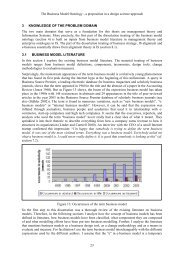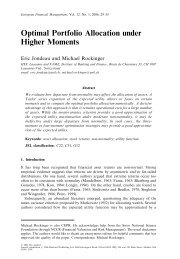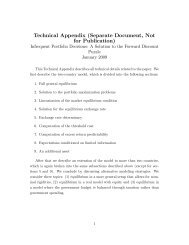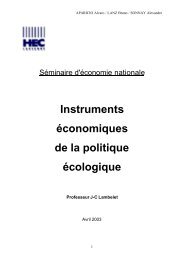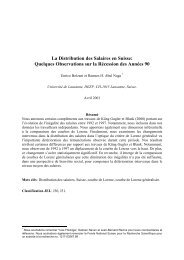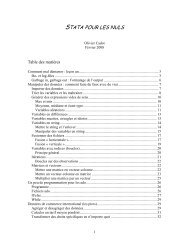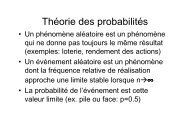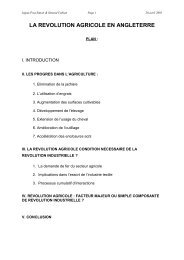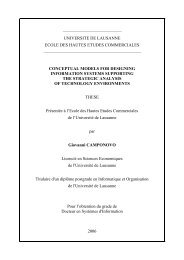Do consumer s tastes differ final 1.7. - HEC
Do consumer s tastes differ final 1.7. - HEC
Do consumer s tastes differ final 1.7. - HEC
Create successful ePaper yourself
Turn your PDF publications into a flip-book with our unique Google optimized e-Paper software.
G.S. Becker: Accounting for Tastes 15<br />
D O C ONSUMER’ S T ASTES D IFFER?<br />
Becker (1998) introduces an approach, which includes “soft values” like leisure for example. As he is<br />
using a rather abstract approach, he does not really apply a concrete sample, but mainly refers to a<br />
household in an economy.<br />
Contrary to most other authors, Becker (1998) supposes that consumption behaviour has only little to<br />
do with basic biological needs for food, drink, shelter and some recreation. He highlights aspects like<br />
childhood and other experiences, social interaction, and cultural influences.<br />
His view reflects the aim to establish a link between two ways of discussing demand: economic or<br />
political and sociological or anthropological. The first often neglects the structure of preferences; the<br />
second does not use an efficient analytical approach.<br />
To allow a broader approach, Becker (1998) includes two new variables for analysing preferences:<br />
P: personal capital<br />
including the relevant past consumption and other personal experiences<br />
effecting current and future utilities<br />
S: social capital<br />
integrating the influence of past actions by peers and others in an<br />
individual’s social network and control system.<br />
The introduction of the above variables changes the utility function, as it not only depends on the<br />
goods consumed but also on the stock of personal and social capital at that moment. The utility<br />
function itself is time-independent, thus being a stable function over time of the goods consumed and<br />
of the capital stocks. As a consequence, the stability of the utility function is mainly due to the<br />
inclusion of past experiences and social influences.<br />
Hereby Becker (1998) has created a revised utility function, which enhances the power of stable<br />
preferences and utility maximisation as it significantly explains a wide range of behaviour. Utility does<br />
not directly depend on specific goods and <strong>consumer</strong> capital stocks, but on the household’s objects of<br />
choice, called commodities – such as health, social standing and reputation, and pleasures of the<br />
senses – produced by themselves. Consequently, the variables in this utility function do not purely<br />
consist of ordinary goods, but additionally of advertisements, education, and other determinants of<br />
preferences normally not considered as “goods“.<br />
Households will therefore maximise a utility function of commodities. These commodities that they<br />
produce themselves are not evaluated by the market price, but by a “shadow price”, the cost of<br />
production. These costs include the quantity of the market good used to produce the commodity, the<br />
person’s own time input, and other input-output coefficients. As these numerous and varied<br />
determinants describe the shadow price, prices do take subtle forms.<br />
Another <strong>differ</strong>ence to usual models is the definition of a household’s income. Contrary to other<br />
approaches, Becker does not use the real income which is the money income deflated by an index of<br />
the prices of market goods. Instead, he uses a household’s full income, representing the maximum<br />
money income it could achieve by an appropriate allocation of the given prices of commodities. As full<br />
income and commodities depend on various factors, a household’s income can take refined forms.<br />
When considering rich and poor, black and white, less and more educated persons, persons living in<br />
countries with totally <strong>differ</strong>ent traditions and their <strong>differ</strong>ent utility functions, Becker uses the approach<br />
that the <strong>differ</strong>ences are due to subutility functions which are not similar due to influences of childhood<br />
and other experiences. Their extended utility functions, however, are regarded as similar. In order to<br />
analyze and explain behaviour in a productive way, the extended utility functions are used in the<br />
model and are considered as stable.<br />
15 This section summarizes Becker, G.S., Accounting for <strong>tastes</strong>, Harvard University Press paperback edition, 1998<br />
B EKE T INNEBERG 12<br />
19 MARCH 2003




